LITTLE ROCK AIR FORCE BASE, Ark. -- Explosive Ordnance Disposal technicians from the 19th Civil Engineer Squadron attended a Tactical Combat Casualty Care (TCCC) Combat Lifesaver (Tier 2) course at Little Rock Air Force Base, Arkansas, April 25, 2024.
The Tier 2 course provides intermediate lifesaving skills and teaches more advanced techniques to treat the most common causes of death on the battlefield by recognizing and preventing life threatening complications of these injuries, treating other associated but not immediately life-threatening injuries, and communicating with and assisting more advanced providers with casualties.
The fundamental methods of TCCC curricula development and implementation evolve from All Service Members (Tier 1) to Combat Lifesaver (Tier 2), expanding from the 5 basic lifesaving skills trained at the basic level to more advanced lifesaving skills.
In addition to these lifesaving skills, the Combat Lifesaver (Tier 2) course also expands the standardized MARCH (Massive Hemorrhage, Airway, Respirations, Circulation, and Hypothermia/Head Injury) protocol with a Tactical Field Care assessment (tactical trauma assessment) to follow a more deliberate approach known as “MARCH-PAWS” (Pain, Antibiotics, Wounds, and Splinting).
This mnemonic can help the Combat Lifesaver remember how to systematically approach each casualty in order to adequately assess and manage injuries; ensuring life-threatening injuries are identified and treated promptly first, and if able, manage and treat other associated but not immediate life-threatening injuries: to include casualty monitoring, i.e. level of consciousness, respiratory/pulse rate.
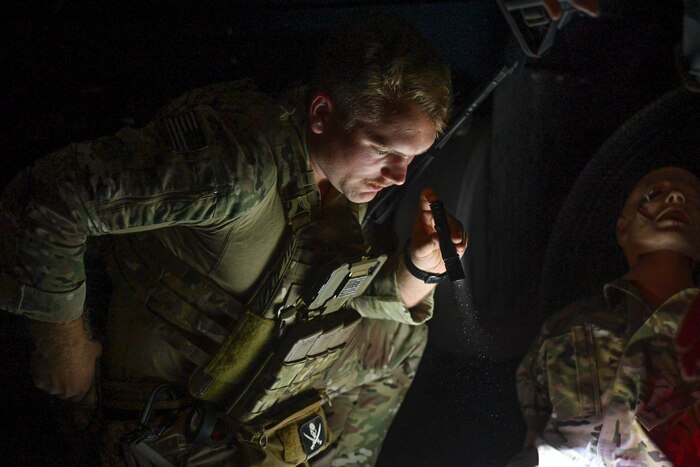
EOD technicians learn advanced lifesaving skillsets
A 19th Civil Engineer Squadron Explosive Ordnance Disposal technician assesses the situation on a training mannequin during the Tactical Combat Casualty Care (TCCC) Combat Lifesaver (Tier 2) course at Little Rock Air Force Base, Arkansas, April 25, 2024. The fundamental methods of TCCC curricula development and implementation evolve from All Service Members (Tier 1) to Combat Lifesaver (Tier 2), expanding from the 5 basic lifesaving skills trained at the basic level to more advanced lifesaving skills.
(U.S. Air Force photo by Airman 1st Class Saisha Cornett)
1 of 7
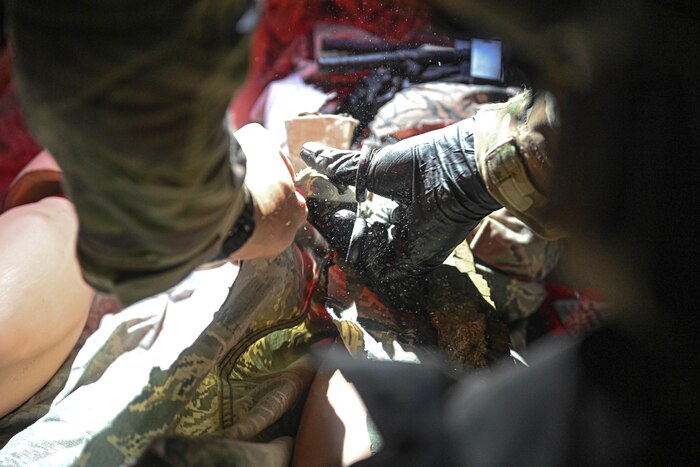
EOD technicians learn advanced lifesaving skillsets
A 19th Civil Engineer Squadron Explosive Ordnance Disposal technician cuts the clothing to access the wound on a training mannequin during the Tactical Combat Casualty Care (TCCC) Combat Lifesaver (Tier 2) course at Little Rock Air Force Base, Arkansas, April 25, 2024. TCCC is designed to help lessen preventable combat deaths by providing proven trauma stabilization techniques, allowing for wounded to survive long enough to receive life-saving treatment. (U.S. Air Force photo by Airman 1st Class Saisha Cornett)
2 of 7

EOD technicians learn advanced lifesaving skillsets
A 19th Civil Engineer Squadron Explosive Ordnance Disposal technician applies a wound-dressing to a hemorrhage simulation training mannequin during the Tactical Combat Casualty Care (TCCC) Combat Lifesaver (Tier 2) course at Little Rock Air Force Base, Arkansas, April 25, 2024. The Tier 2 course provides intermediate lifesaving skills and teaches more advanced techniques to treat the most common causes of death on the battlefield by recognizing and preventing life threatening complications of these injuries, treating other associated by not immediately life-threatening injuries, and communicating with and assisting more advanced providers with casualties. (U.S. Air Force photo by Airman 1st Class Saisha Cornett)
3 of 7
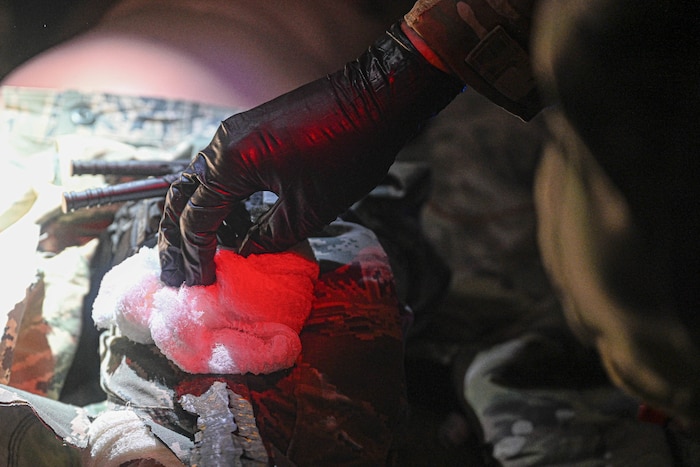
EOD technicians learn advanced lifesaving skillsets
A 19th Civil Engineer Squadron Explosive Ordnance Disposal technician applies a wound-dressing to a hemorrhage simulation training mannequin during the Tactical Combat Casualty Care (TCCC) Combat Lifesaver (Tier 2) course at Little Rock Air Force Base, Arkansas, April 25, 2024. TCCC is designed to help lessen preventable combat deaths by providing proven trauma stabilization techniques, allowing for wounded to survive long enough to receive life-saving treatment. (U.S. Air Force photo by Airman 1st Class Saisha Cornett)
4 of 7
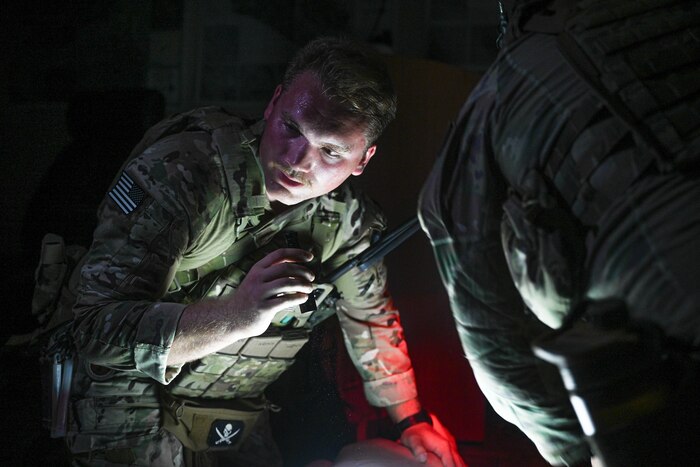
EOD technicians learn advanced lifesaving skillsets
A 19th Civil Engineer Squadron Explosive Ordnance Disposal technician assesses the situation on a training mannequin during the Tactical Combat Casualty Care (TCCC) Combat Lifesaver (Tier 2) course at Little Rock Air Force Base, Arkansas, April 25, 2024. The Tier 2 course also expands on the standardized MARCH (Massive Hemorrhage, Airway, Respirations, Circulation, and Hypothermia/Head Injury) protocol with a Tactical Field Care assessment to follow a more deliberate approach known as “MARCH-PAWS” (Pain, Antibiotics, Wounds, and Splinting). (U.S. Air Force photo by Airman 1st Class Saisha Cornett)
5 of 7

EOD technicians learn advanced lifesaving skillsets
A 19th Civil Engineer Squadron Explosive Ordnance Disposal technician attends to patients during a Tactical Combat Casualty Care (TCCC) Combat Lifesaver (Tier 2) course at Little Rock Air Force Base, Arkansas, April 25, 2024. TCCC is designed to help lessen preventable combat deaths by providing proven trauma stabilization techniques, allowing for wounded to survive long enough to receive life-saving treatment. (U.S. Air Force photo by Airman 1st Class Saisha Cornett)
6 of 7
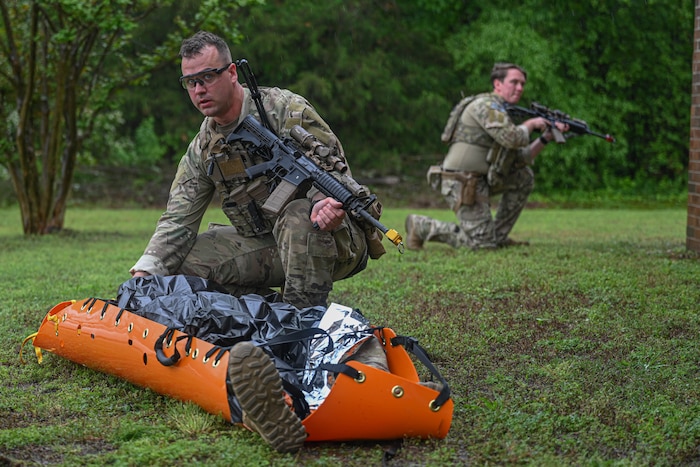
EOD technicians learn advanced lifesaving skillsets
A 19th Civil Engineer Squadron Explosive Ordnance Disposal technician covers a patient with a blanket during a Tactical Combat Casualty Care (TCCC) Combat Lifesaver (Tier 2) course at Little Rock Air Force Base, Arkansas, April 25, 2024. The “MARCH-PAWS” mnemonic can help the Combat Lifesaver remember how to systematically approach each casualty in order to adequately assess and manage injuries; ensuring life-threatening injuries are identified and treated promptly first, and if able, manage and treat other associated but not immediate life-threatening injuries to include casualty monitoring. (U.S. Air Force photo by Airman 1st Class Saisha Cornett)
7 of 7
Furthermore, pre-evacuation and evacuation communication and procedures are provided at this tier to ensure every Combat Lifesaver is able to communicate MIST (Mechanism, Injury, Signs/Symptoms, and Treatment) reporting and 9-Line coordination, or a medical evacuation request. This also includes packaging casualties for evacuation and documentation.
The scope for the Combat Lifesaver is to “See something, do something, and assist the Medic doing something else.”
In hazardous situations involving explosives, accidents can happen unexpectedly, making it essential for EOD members to be prepared to administer TCCC aid promptly and effectively. Having advance TCCC skills enables them to provide immediate medical assistance to themselves and their wingmen, potentially saving lives or minimizing the severity of injuries until professional medical help arrives.